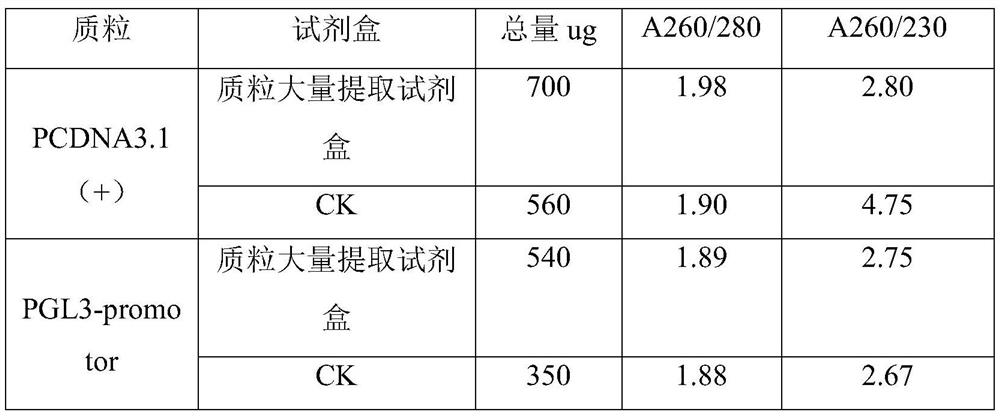Plasmid extraction kit and extraction method
A kit and plasmid technology, applied in the field of molecular biology, can solve the problems of bacterial genomic DNA contamination, organic reagent contamination, low plasmid concentration, etc., and achieve the effects of reliable quality, high recovery rate and good purity
- Summary
- Abstract
- Description
- Claims
- Application Information
AI Technical Summary
Problems solved by technology
Method used
Image
Examples
Embodiment 1
[0025] Example 1 Cultivation of DH5α Escherichia coli carrying pCDNA3.1(+) and pGL3-promoter plasmids respectively.
[0026] Take out the strains or single-clonal plaques from the refrigerator at -80 degrees Celsius, inoculate DH5α Escherichia coli carrying pCDNA3.1(+) and pGL3-promoter plasmids into 1ml medium test tubes respectively, shake and culture at 37 degrees for 8 hours, and rotate 200rpm, after 8 hours, transfer 1ml of cultured bacteria solution into 25ml of culture medium, shake overnight at 37°C (about 15 hours), and rotate at 200rpm. Centrifuge the bacterial liquid cultured overnight at 5000rpm (3800×g) for 5 minutes, discard the medium and keep the precipitate.
Embodiment 2
[0027] Example 2 Plasmid extraction.
[0028] Add 10ml of SI buffer into the cell pellet, and fully suspend the cell. The composition of the S I buffer solution is as follows: 1M Tris-HCl, 0.5M EDTA and 1M glucose, pH=8.0.
[0029] Add 10ml of S II buffer to the suspended bacterial solution, mix slowly (do not shake violently), and lyse. The operation time should not exceed 5 minutes (to prevent genome contamination). The components of the S II buffer are as follows: 2M NaOH and 10% SDS.
[0030] Then add 14ml of S III buffer solution to the lysis system, mix slowly and evenly (do not shake vigorously), and a flake precipitate appears. Centrifuge at 3000 rpm for 10 min, and carefully transfer the supernatant to a new centrifuge tube with a pipette to obtain the supernatant. The composition of SIII buffer is as follows: 3M potassium acetate, 2-3M guanidine hydrochloride and 2M acetic acid.
[0031] Add 18mL of PS cleaning solution to the centrifuge tube, turn over gently se...
Embodiment 3
[0033] Example 3 Plasmid concentration and purity determination.
[0034] Put the adsorption column into a new centrifuge tube and use 0.5ml ddH 2 O (or TE) dissolves the precipitate to obtain a plasmid solution. The A260 is measured by an ultra-micro spectrophotometer, and the quantitative A260 / A280 ratio is generally between 1.8 and 2.0. Plasmid purity was checked by agarose electrophoresis. The TE buffer composition is as follows: 100 mM Tris and 10 mM EDTA (pH 8.0). After testing, the plasmid concentrations of PCDNA3.1(+) and PGL3-promotor extracted by this kit were 700ng / ul and 540ng / ul respectively, which were higher than 560ng / ul and 350ng / ul of the control kit; the values of A260 / A280 were both Between 1.8-20.0.
PUM
 Login to View More
Login to View More Abstract
Description
Claims
Application Information
 Login to View More
Login to View More - R&D Engineer
- R&D Manager
- IP Professional
- Industry Leading Data Capabilities
- Powerful AI technology
- Patent DNA Extraction
Browse by: Latest US Patents, China's latest patents, Technical Efficacy Thesaurus, Application Domain, Technology Topic, Popular Technical Reports.
© 2024 PatSnap. All rights reserved.Legal|Privacy policy|Modern Slavery Act Transparency Statement|Sitemap|About US| Contact US: help@patsnap.com










